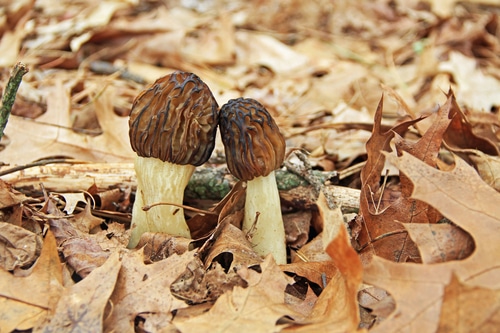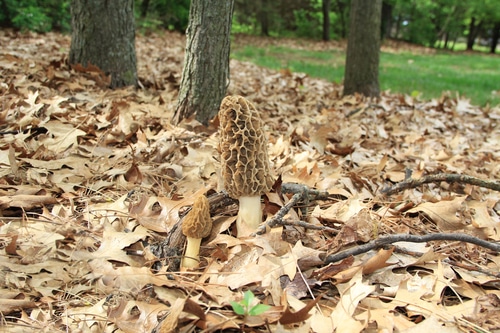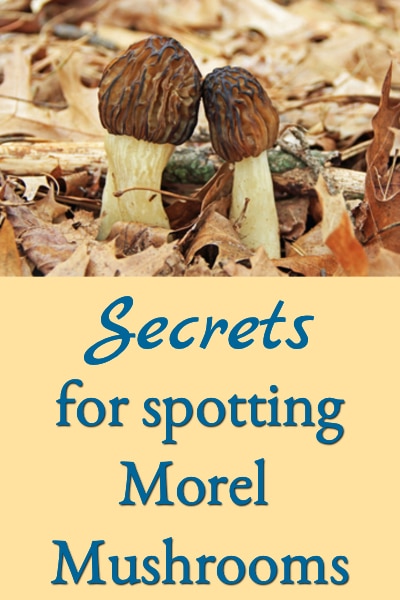Why Hunt Morel Mushrooms? 
Foraging for morel mushrooms (even though spotting them is tough) is an annual spring activity enjoyed by millions of people. It’s extremely popular because morels are the easiest mushrooms to identify and they have excellent flavor (I’ve seen dried morels priced at $299/lb. in stores because of their fantastic flavor).
Morels are easy to identify because of their distinctive appearance and because they’re entirely hollow (scroll down to see the picture of one split). The only other mushroom that looks similar to a morel has a cap (and should not be eaten) rather than being entirely hollow inside (you can see examples of the difference HERE).
Since morels are so distinctive in appearance and it’s easy to verify that they’re truly morels (simply cut them in half and make sure they’re hollow) food foragers can feel confident about picking and consuming these delectable wild mushrooms.
Timing Is Everything for Spotting Morel Mushrooms
Morels don’t start showing up until daytime temperatures are in the 60’s and nighttime temperatures are in the 50’s. They appear on southerly slopes and in sunny spots before showing up on northern slopes or in the shade.
Natural indicators that it’s time to look for morels include lilacs budding, open mayapples, and flowering bloodroot, trillium, dandelion, and columbine.
Morels often emerge after a warm spring rain when temperatures are right and that’s an excellent time to go try spotting morel mushrooms.
To get an idea of when to hunt morel mushrooms in your location, you can track the progression of morel sightings from South to North each year by clicking here.
Where To Find Them
Morel mushrooms have been found nearly everywhere outdoors but the following locations are particularly good places to look for them:
- Near dead or dying trees – especially dead or dying elm and ash trees. Old apple and peach orchards are also good.
- At the base of slopes with mossy ground or heavy ground cover.
- In river or stream bottoms where the soil is sandy.
- At the edge of woods or fields, and around tree stumps.
They are almost always found in locations where the sun is hitting the ground.
There are three main types of morels that appear each spring – black morels, white morels, and giant morels. The blacks appear first and can usually be found for about 10 – 14 days. The whites appear about a week after the blacks and the giants again about a week after the whites.
Good places to look for blacks include hardwood forests, apple orchards, and along roadsides. The whites are usually found in moister conditions near streams, lakes, dead or dying elm trees, and apple orchards. The giants prefer richer soil and warmer climates.
How You Search Is Important For Spotting Morel Mushrooms
Most successful morel foragers recommend walking slowly and looking about 10 feet ahead to spot morels. Many also suggest that most of your time should be spent looking rather than walking and that using a hiking stick to flip over fallen leaves, pieces of bark, and mayapple leaves will greatly increase success rates.
Morels are very difficult to spot – they seem to have an amazing ability to hide in plain sight. However, once you find one, be sure to look around the immediate area carefully. Where there’s one there are usually more!

Even a very large morel like the one in the photo below can be difficult to spot; however, as you gain experience spotting them it seems to get easier.

How To Harvest & Transport Them
Once you’ve gotten past the hurdle of spotting morel mushrooms, then there a best practices for harvesting and transporting them. These practices help insure they’ll be future harvests in upcoming years.
It’s best to use a sharp knife to cut the morels off just above the ground to harvest them. Don’t disturb the mushroom “roots” by trying to pull them from the ground, cut them instead so that the mushrooms will continue to grow in the future.
You should always use a mesh bag to collect and transport any mushrooms you find. This lets the mushrooms breathe and it also spreads the spores throughout the fields and woods as you move about. You literally “reseed” mushroom spores so other morel mushroom crops can be harvested in the future.
If you do happen to hit the morel mother load and need ideas on how to fix them, try them in Easy Beef Stroganoff.
Happy Hunting!












































